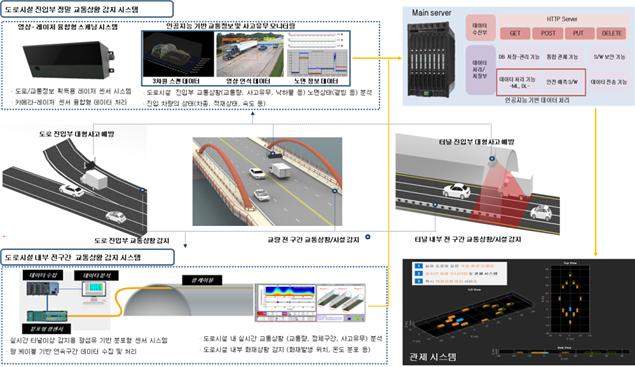– Detect traffic flow and unexpected situations using optical sensors, and provide driver notifications
– This year, pilot operation of demonstration sites in major transportation facilities such as tunnels
Gwangju Metropolitan City announced on the 21st that it has succeeded in 'development of a system and artificial intelligence-based data analysis technology that can detect the traffic conditions of road facilities in the city in real time' through a disaster safety research and development project hosted by the Ministry of the Interior and Safety.
This technology development was carried out with an investment of KRW 16 billion, including KRW 21 billion, as one of the ‘development and demonstration of road facility abnormality detection and accident prevention system using intelligent optical fusion sensors’ promoted as a MOPAS regional disaster safety problem solving R&D support project. .
This technology is a traffic detection system that uses optical sensors installed in traffic facilities to identify traffic flow and at the same time detect fires, congestion, collisions, road ice and unexpected situations to provide a notification to the driver. In the developed system, a fiber optic sensor that analyzes the location of an accident through an optical cable laid around a traffic facility and an optical sensor that precisely scans major traffic monitoring sections were simultaneously applied.
It is a state-of-the-art disaster prevention technology that can quickly respond to accidents and prevent secondary accidents by processing the data collected through AI learning and providing necessary information to drivers.
In the first year (1), Gwangju City developed the optical sensor and data collection system core technology, and in the second year (2020), the performance of the developed product was confirmed through the production of a prototype of the traffic detection system and an integrated simulation test.
This year, the 3rd year (2022), is a period for demonstrating the developed technology. After establishing a demonstration site in transportation facilities such as tunnels, bridges, and underpasses in Gwangju, pilot operation is planned.
Previously, Gwangju City formed a consortium with the Korea Institute of Optical Technology, the Korea Electronics Research Institute, Gwangju Regional Headquarters, IMR Co., Ltd., and the Korea Institute of Disaster and Safety Technology Foundation for research and development. The result was achieved through cooperation between diagnostic solution specialists.
Park Nam-eon, head of the city’s civil safety office, said, “We expect that it will be effective in preventing major accidents as well as providing prompt and accurate traffic information through traffic flow and unexpected situation detection through artificial intelligence and big data learning. It is expected to have the effect of reducing the accident rate,” he said.
※ Attachment: Conceptual image of optical sensor-based intelligent traffic detection system




